Existing User Log In
New User Registration
Register for a free account to gain full access to the VGChartz Network and join our thriving community.



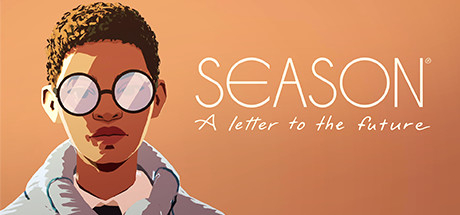

America - Front
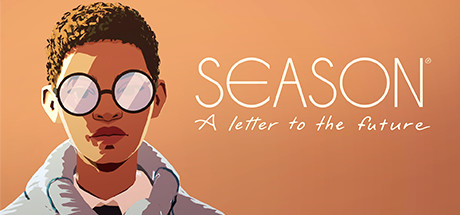

America - Back

SEASON: A letter to the future
Scavengers Studio
Adventure
 (Add Date)
(Add Date) (Add Date)
(Add Date) (Add Date)
(Add Date)
| Owners: | 0 |
| Favorite: | 0 |
| Tracked: | 0 |
| Wishlist: | 0 |
| Now Playing: | 0 |
[Reviewer's Note: I will bring up parts of the game’s early setup, which requires me to delve into a couple of SPOILERS. It’s tough to avoid them when this aspect of the game is so important to my overarching evaluation. Read on at your own risk.]
The sounds of a frog chorus in a pond. An old-timey radio jingle played on a loop. Rusting metal support struts creaking against a strong gust of wind. In Scavengers Studio’s first outing, Darwin Project, such sounds might serve as mere background to intense Battle Royale bouts being recorded for televised entertainment. Hell, the e-sports announcer was vital in delineating it from the competition upon its E3 reveal. Now, the background, those little things, are the core to this team’s serene sophomore outing; and it speaks louder than any on-air personality that such a creative heel-turn feels more consistently engaging.
A new prophecy has been foretold: the end of the current “season” is nigh! The importance of these supposedly-cataclysmic epochs, this seasonal renewal process, isn’t initially clear, but it compels the protagonist to venture from the quaint Caro Village and into the vast wilderness. Her goal is simple: to record, photograph, sketch, and write in her handy-dandy scrapbook for future generations; to craft a time capsule/travelogue for this season. Equipped with the clothes on her back, a bicycle, and the recording equipment she can carry, she leaves her secluded homestead behind.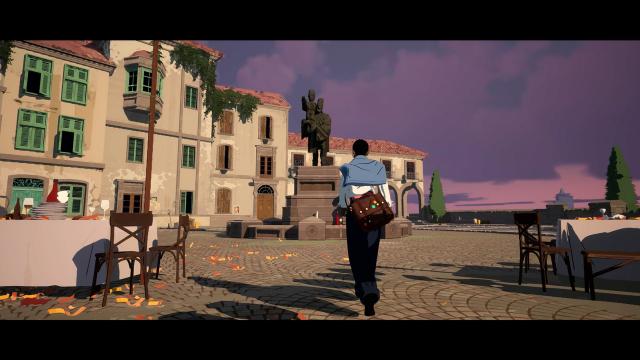
But that chronological beginning isn’t the actual start of SEASON. Its subtitle, “A letter to the future,” is shown with an unknown man rifling through her belongings and opening the scrapbook. This additional context, framing everything as an interactive epistolary tale, is further expanded by the seemingly-typical opening. The walking sim template of exploring an enclosed space & interacting with various trinkets for development is quite basic and effective. Plop a character in their room, have some internal monologue for every important doodad in arm’s reach, and you have an establishing scene.
What narrative designers Jane Tan, Kevin Sullivan, & Megan Hutchinson pair with this opening is an important sacrifice. Strolling outside the town’s limits comes with potentially losing your mind. This strange affliction can be repelled with a special pendant; however, that requires someone offering past memories of their own. Not only do interactable items have a story to tell, they’re also a potential sacrifice that your mother’s willing to lose. There’s something so poignant about being a “memory martyr,” of losing a small part of yourself, that’s so effectively communicated by this too. Although the protagonist (voiced by Maureen Adelson) and her mom (voiced by Phyllis Gooden) have tranquil temperaments, there’s an aquifer of passionate emotion between them and this unique scenario.
Before even fiddling with your vintage recorder and camera, these background dynamics have already layered so much to your place within this world. Similar to concentric circles, each of these contextual elements reminds you of what’s at stake: her personal curiosity, familial sacrifices, the village’s approval of this journey, and the preservation for the future to dissect and appreciate. All of these primary and auxiliary details reinforce how important each page is in the grand scheme. It captures a similar design premise to The Gliding in Sable, in that every action implicitly channels into your main goal.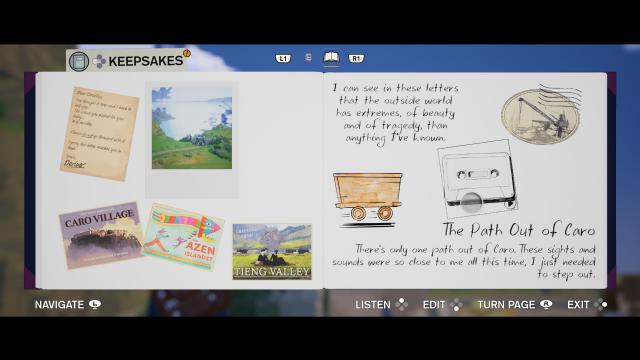
Permission to play with her accoutrements comes after leaving the house. The recording tape is simple enough: search for any sound within the environment and hit record near it, concomitantly feeling it through the DualSense; of all the haptic feedback variations, the coolest one is feeling the needle scratch along a vinyl’s surface. On the more complicated side, the antique camera has a bunch of options to play around with: zoom, draw distance, color filter, and so on. Beyond being the typical means of unlocking more monologue snippets, the extra complexities go a long way in wanting to capture the perfect shot.
The confection of walking, biking, and scrapbooking sim keeps to a nice rhythm: each level (or section) is dedicated two pages to place Polaroids, succinct quotes, audio recordings, and so on. Each of these taken becomes a keepsake to place however you wish - expand/shrink in size, set in an orderly fashion, or a mottled collection of wild angles and overlapping minutiae. Fill up these pages enough (usually five unique keepsakes in total) to get a short cut scene with an extra quote and page-exclusive drawings that can be incorporated with everything else.
This type of freeform anthologizing isn’t the entirety, however. Roughly 20% of the book is more objective-driven, varying from learning more about a regional god to uncovering more about a mysterious association. These pages will have pre-determined slots to place keepsakes; for instance, a greyed-out image will clue you in on what photo to take within the immediate area. The act of doing these mini-chores isn’t interesting by itself, but still successfully serves as a low-voltage cattle prod to maintain some direction.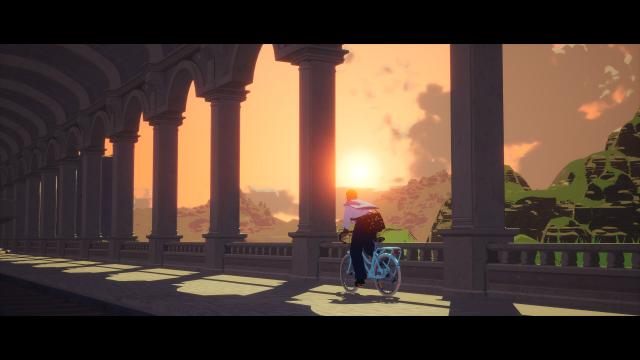
When the training wheels come off, SEASON gets to flex these elements – along with some light puzzling – within a quasi-open world. Adding onto the previously-mentioned emotional context, this explorable valley won’t be around for much longer, making your documentation all the more meaningful. To reference Shedworks’ Sable again, even though the end goals are different, the focus on heuristic discoveries is fundamentally similar. Sure, you’re given a greyed-out map before entering, but you’re also able to freely hop here or there without any prompts or UI elements road-blocking certain areas. There’s a blanket invitation to see something in the distance, be it a large statue or cow farm, and document its best qualities.
It’s a fundamentally sound split between exploring and cataloguing occasionally hindered by speedbumps. Biking hither and thither is fine, with feeling the chain’s tension through the DualSense being the highlight, but bumping into practically anything results in a full-stop and an animation of the protagonist casually hopping off the bike. I’m not expecting something like Rockstar’s Euphoria Engine in physics and animation, but it’s an annoying detail that temporarily saps momentum. On rare occasions the scrapbook’s UI can act buggy by disallowing you from dragging a picture to one side or the other. The issue typically fixes itself by opening & closing the scrapbook several times to reset; at worst, restarting to main menu also works.
Beyond quality-of-life annoyances, a more overarching critique stems from not going as far as it interactively could. How much further could you go by manipulating the environment to craft wholly unique recordings? It doesn’t even have to be some Rube Goldberg machine either. Just imagine if you could roll something down a hill and chase it with tape recorder in hand. Maybe specific interactions with the Valley’s last residents could enable special opportunities for rare pictures or musical tracks. This isn’t to outright ignore the infrequent times your actions do alter the world, but something doesn’t add up when I’m thinking of more interactive avenues this concept can explore.
Even if the surroundings you document are typically static, at least the stories within the world feel lively and dynamic. It’s tough to gauge SEASON’s story in certain respects. There isn’t a traditional Hero’s Journey, nor a Big Bad to surmount with the almighty power of Polaroids and audio tape. That doesn’t discount any character growth or introspection, but by crafting the narrative structure around a transient sojourner it feels more like an extended documentary with fictional lore in the background. The world-building in particular adds so much weight because of how well it drip-feeds information. I was genuinely caught off-guard by how much I was thinking about the alleged mental disease, the coming end of a season, a war from a previous era, and more. It’s fitting in the end credits to see “narrative designer” credits instead of “writers” credits: they walked a tightrope between player-authored storytelling while still managing to make it feel like a structured tale.
It’s just a shame not all of the elements click together. Although the protagonist and her family hit their marks, the voice acting for other side characters is a mixed bag. The in-game dialogue sequences were the main venue for many staid line-reads. Beyond presentational foibles, most of the final act is structurally jumbled. The whole… “will she or won’t she?” choice you make for a different ending feels so forced. From the lack of proper build-up to the way it’s thrust upon you leaves a sour taste, even after the heartfelt final minutes.
The story may be mismanaged, but the audio & visual design remain consistent. Part of what tickles my collect-a-thon itch is in appreciating the potent mix of Pacific Northwest & Midwestern plains, complimented by mountainous ranges in the distance. SEASON doesn’t rise up to become the Best of Yet Another Indie Game™ in art direction or soundtrack, but both succeed in capturing an idyllic place to explore. It’s more interested in you appreciating vintage records played in-game than blaring acoustic background music; similarly, more attention is given to its admittedly-hipster aesthetic than blowing the budget on the most intricate skyboxes or detailed textures. A fair trade-off for what’s still a lovely-looking and sounding experience.
After the credits rolled, it’d dawned on me that I lost track of how long it took to complete. I’ve broadly guessed between 6-11 hours, but that’s as close as my internal clock can register. I could look it up via account information, but that’d spoil the magic in my view. Even if ultimately on the lower end of the scale, that seems suitable for a $30 title. Monetary value consideration aside, leaving me ensorcelled to the point of losing track of time is an endorsement by itself.
Making a creative heel-turn away from bombastic multiplayer, Scavengers Studio's sophomore effort finds greener pastures. By tying earnest emotional context of what’s essentially a scrapbooking mini-game into a full-course meal, SEASON: A letter to the future finds a nuanced collect-a-thon concept that ties into its hands-off design ideal. Your inquisitive nature propels you to save a little piece of history, be it the sights, sounds, or both, before it’s washed away. The road trip isn’t without design or storytelling speedbumps - some minor, others sizable. But by the end, I knew the trip was worth it.
Contractor by trade and writer by hobby, Lee's obnoxious criticisms have found a way to be featured across several gaming sites: N4G, VGChartz, Gaming Nexus, DarkStation, and TechRaptor! He started gaming in the mid-90s and has had the privilege in playing many games across a plethora of platforms. Reader warning: each click given to his articles only helps to inflate his Texas-sized ego. Proceed with caution.









